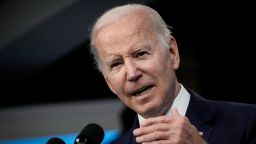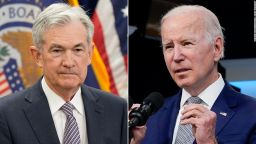It’s rare for anyone in Washington to admit they were wrong.
So Treasury Secretary Janet Yellen’s admission in an exclusive interview Tuesday on CNN that she was incorrect to believe last year that inflation was not a long-term threat was quite a moment.
The administration could have gotten credit for candor and an unusual expression of humility, but a Treasury spokesperson soon tried to paper over Yellen’s admission, instead emphasizing the unforeseen events that exacerbated inflation, which Yellen had also detailed on CNN.
“I think I was wrong then about the path that inflation would take,” Yellen told CNN’s Wolf Blitzer when asked about comments from 2021 that inflation posed only a “small risk.”
“As I mentioned, there have been unanticipated and large shocks to the economy that have boosted energy and food prices and supply bottlenecks that have affected our economy badly that I, at the time, didn’t fully understand, but we recognize that now,” Yellen said.
Yellen’s statement appeared to be a symptom of a deep political hole facing the White House five months before the midterm elections. Telling Americans that the economy is strong, there are 8.3 million new jobs and inflation should be lower by the end of the year isn’t working for President Joe Biden.
But Yellen’s honesty aside, Biden’s intractable position was only reinforced Tuesday by the fact that much of his team’s new PR blitz – designed to show the President feels the country’s pain – doubled down on the same failed formula and a message to voters that while the anguish they are feeling from higher prices is real, the economy is doing better than they think.
The White House isn’t lying. The economy is mostly in good shape, especially considering the punishing impact of a once-in-a-century pandemic and the disastrous impact of Russia’s war in Ukraine and Covid-19 lockdowns in China. Consumers are still spending despite higher prices and there are signs of a summer travel boom as the coronavirus appears less of a threat.
But the highest inflation rates since the early 1980s mean that Americans generally are not feeling what the President says is happening. This kind of disconnect is politically unsustainable.
A new Gallup poll on Tuesday, for instance, underscored the gloom felt by many US adults over the state of the economy – in a way that threatens to doom Democrats in November’s midterm elections and hand Republicans power in Congress.
Only 1% of those polled thought the current economic conditions were excellent; 13% said they were good; 39% said conditions were only fair; and a devastating 46% judged the situation as poor. And 77% of respondents said the country’s economic outlook is getting worse.
It’s hard to imagine a less favorable political environment for a party that controls the House, the Senate and the White House and faces congressional elections. Republicans may not have announced any plans to do better. But the joy of opposition is that they can sit back and watch the slow-moving nightmare afflicting the party in power.
A new White House economic push
Given this backdrop, it’s not surprising the White House is launching a monthlong focus on the economy, designed to convince the country that high prices crimping family budgets are the President’s number one priority, despite the largest war in Europe since World War II and a pandemic reluctant to release its grip. Senior administration officials fanned out across cable television on Tuesday to bolster Biden’s argument, laid out in a Wall Street Journal op-ed, that his upbringing in a family that suffered when gasoline and food prices rose meant he especially understands what the country is going through now.
But consider these dueling scenes.
Drivers setting out on the Memorial Day weekend, which traditionally marks the start of summer, stared back at pumps showing near-record average prices just shy of $4.60 for a gallon of gas.
The day after the holiday, Biden welcomed Federal Reserve Chair Jerome Powell to the Oval Office and stressed that he would get out of the way and give the central bank room to do its job in curbing inflation.
“My job as President is not … only (to) nominate highly, highly qualified individuals for that institution, but to give them the space they need to do their job. I’m not going to interfere with their critically important work,” Biden said on Tuesday.
It’s not hard to see that the sense of urgency voters are feeling might not be satisfied by such a staid photo op. Biden’s approach may demonstrate the kind of good governance and respect for the Fed’s independence that was noticeably lacking in the chaotic Trump administration. But as a political strategy, putting the onus on a body that is being widely criticized for waiting too long to raise interest rates in order to tackle inflation seems unlikely to shift voter perceptions. Biden supporters might complain that such critiques are rooted in punditry. But the administration’s problem is one of perception, as voters fail to see the strengths of the economy the President tries to stress.
The White House’s case is not helped by the fact that like the Fed, it suffers from tarnished credibility on inflation, after repeatedly insisting last year that rising prices for food and other goods were “transitory.” It’s fair to argue, as Yellen did on CNN, that unforeseen factors, including the war in Ukraine and China’s failure to shake off Covid-19, which has caused new supply chain reactions, were unexpected shocks that made previous predictions wrong.
Such honesty from Yellen about not fully understanding the impact of those shocks is refreshing in a public official. But such nuance won’t fly on the midterm election campaign trail, which history suggested was always going to be inhospitable for Democrats but is now looking dire. Republicans are certain to take her comments and frame an argument that even Biden’s Treasury secretary admits his economic policies are not working.
What can Biden do?
Part of the problem for the administration is that it has already used the items in its political arsenal that can be deployed without a significant cost. Biden has released millions of barrels of oil from strategic reserves to combat rising energy prices sparked by the war in Ukraine. But pump prices keep going up. Blaming the increase on “Putin’s price hike,” as the President has done, might feel good politically. But it doesn’t do anything for angry drivers.
Biden has also made significant efforts to reduce port congestion fueled by a supply chain crunch that followed the pandemic, when problems with supplies and high consumer demand caused inflation to skyrocket. But he can’t control what happens outside the US, and the global factors that caused the problem are still playing out. Additionally, expected shortages of grain and sunflower oil brought on by a disrupted harvest and transportation of crops out of Ukraine, a major producer, later this year are threatening food shortages and higher prices closer to Election Day.
Some analysts have suggested that the President could mitigate some of the pain of inflation by ending Trump-era tariffs on China or by encouraging more immigration to stem labor shortages that are contributing to higher prices. But either approach would expose Democrats to Republican claims that they are soft on China or are simply throwing the county’s borders open. Both charges would be misleading, but they might well pay off for the GOP politically.
In his Wall Street Journal op-ed, Biden touted several measures in his stalled domestic agenda that he said would help cool the cost of living. He called on Congress to pass clean energy tax credits that he said would lower a typical family’s utility bills by $500 a year. He also said family budgets could be helped by lowering the cost of prescription drugs like insulin and argued that reducing the federal budget deficit could help ease price pressures.
The problem, however, is that all these measures will take time or require action by Congress. Much of Biden’s domestic agenda has been stalled – not just by Republican obstruction but by his inability to convince the Democrats in the Senate to unite to pass it. One moderate Democrat, Sen. Joe Manchin of West Virginia, has specifically named inflation as the reason he’s not keen on extra government spending.
Given Biden’s limited options, the White House has little choice but to do what it set out to do yet again on Tuesday: Remind Americans of the strengths of the economy, job growth and the relative health of the position in the US compared with those of some foreign nations.
None of this is likely to cut through, given voters’ dire perceptions of how tough things really are. But Biden has few other options.








